Japanese Guide¶
If you don't need a preface, please skip to 2.1 How to learn Japanese
1.1 Why many people "fail" to learn Japanese¶
Many people have simple goals in mind when learning Japanese: to enjoy untranslated Japanese content and to speak Japanese fluently. You'll hear everyone say something along those lines when asked about their learning goals. However, many also fail to reach these goals even after years of study. Is the language just too hard? Are they just not studying hard enough?
I believe it's actually not their fault, but rather the method's. In language learning, the method behind your learning makes a huge difference in the kind of progress you make.
As it turns out, reaching such goals is not possible with "traditional" methods of Japanese learning. Many students are led to failure for not including a crucial ingredient, immersion, into their study routines. Immersion refers to listening to or reading native content made for native speakers. For example, anime is originally in Japanese without subtitles, so when consumed in this form, we call it immersion.
1.2 Problems with traditional methods¶
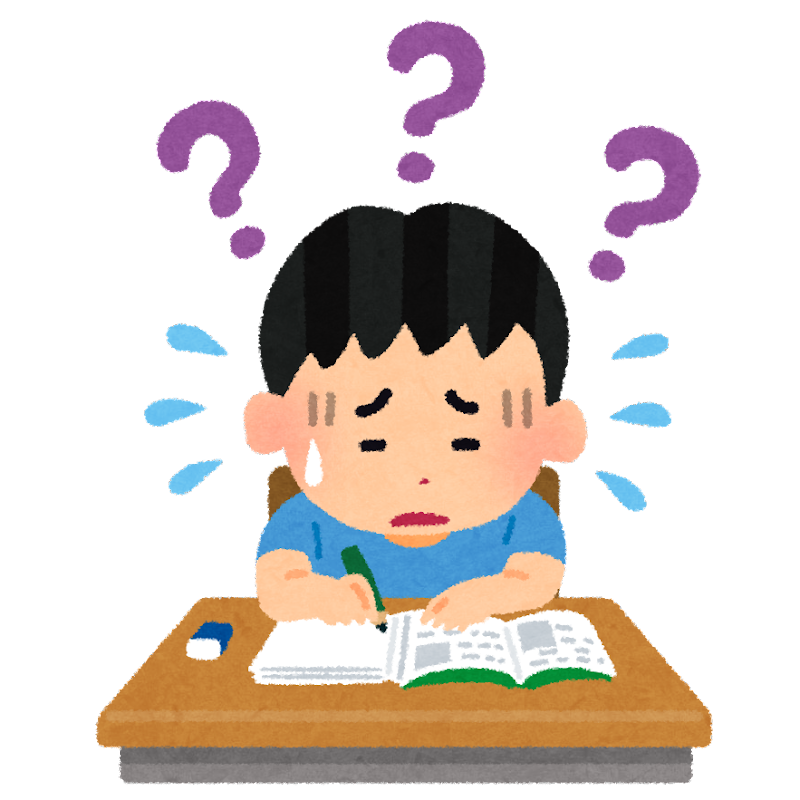
A Japanese learner following a “traditional” study method would usually go through the following steps:
- Learning the alphabet(s).
- Learning basic sentences such as greetings and self-introductions.
- Learning basic grammar structure and vocabulary.
- Coming up with sentences either by having conversations with a tutor or study partner, or by writing.
- Translating example sentences from their native language to their target language and vice versa.
- Looking up further material about grammar structures and vocabulary in textbooks or YouTube videos recommended by a tutor.
- Practising conversation using knowledge from their study.
- Accumulating more vocabulary and grammar structures, which becomes a measure of one’s own progress
- And finally, in the endgame, moving to or visiting Japan in hopes of having opportunities to practise their skills.
None of that is bad in itself, it is actually sufficient study, but it's not enough to get you to a high level of proficiency. The problem is they aren't actually engaging with the real language—but what do I mean by that?
Let's take swimming as an example. You can't just stay in the baby pool with floaters and take your time to become a pro at the baby pool before attempting to swim in a real pool. This won’t make you a good swimmer. You also can't expect to become a good swimmer just by learning the theory behind the techniques in isolation and practising them without actually swimming in a real pool.
How about a more relatable example: competitive video games. You won’t get better at the game just playing against the AI and grinding in training mode all day. You have to play the real game against other people even if you think you’re going to lose by a landslide. This is "playing the real game", with no strings attached.
A common trap students fall into in language learning is staying on beginner resources for too long.
They want to ensure they know every single detail of their basics and refuse to move on to the real language. They refuse to engage in anything they aren't already comfortable with, because they're too afraid of not understanding anything. They may feel like they aren't “ready". Yet it’s important to leave your beginner resources as soon as possible because, in reality, you will never be ready until you actually start engaging with the real language and get yourself used to it.
Perfectionism can be a double-edged sword in language learning. As a perfectionist myself, I've suffered more than I've gained wanting to make sure I've gotten every single detail down of trivial things that didn't really matter in the big picture.
Learning a language is like climbing a mountain. You can try to climb that mountain without anything assisting your ascent, and though it will take lots of struggle, you will eventually make it if you persist. Traditional study is like building a rope so that it's easier to climb that mountain, but you can't climb the mountain just by making a rope! You eventually have to climb it, because no matter how much rope you decide to make climbing that mountain is still going to be difficult and time-consuming.
1.3 The scale of language¶
Language is… huge. There's so much to it that far exceeds the limitations of a classroom or app-based approach that tries to teach in an "x means y" or "x does y" format. Mastering a language to a higher level requires enormous amounts of experience reading and listening to what native speakers say.
It's often difficult to grasp why they tend to use that phrase in this context, or this word instead of that other one… This creates a barrier for us learners as we can't just study grammar and vocabulary to achieve native-like fluency.
Without the prerequisite experience, attempting to construct sentences in your target language often leads to unnatural, or difficult to understand phrasing. In turn, lack of experience with how native speakers use their language makes it difficult to understand them, due to unfamiliarity with phrasing outside of a learning resource's scope.
This is why in your learning routine, you do what we call "immersion"—read and listen to what natives write and speak.
Language learning is a process of subconsciously memorising patterns with comprehensible input. What this means is, when you understand something (comprehensible) in your immersion (input), your brain subconsciously stores that pattern for later information retrieval. You see, being able to comfortably read this guide is only possible because you have so much experience reading English in the past that, when you read this, your brain thinks something like, "Oh, there's pattern #234 used with pattern #82 and pattern #10!".
And since you are a proficient English reader, this is done effortlessly. You can understand the words in these sentences. You can understand what links the sentences together. You can even detect the tone and degree of formality in my writing, and it's all thanks to your brain storing the context, and other information of all the language patterns that you've come across.
Notice how I haven't mentioned "knowing the grammar" or "having memorised the vocabulary"? This is because you don't organically process language in this manner. Some readers may not even be native speakers and probably have studied English grammar before, but it is unlikely they're actively thinking about it when coming into contact with English every day.
1.4 Coming to terms with sucking¶
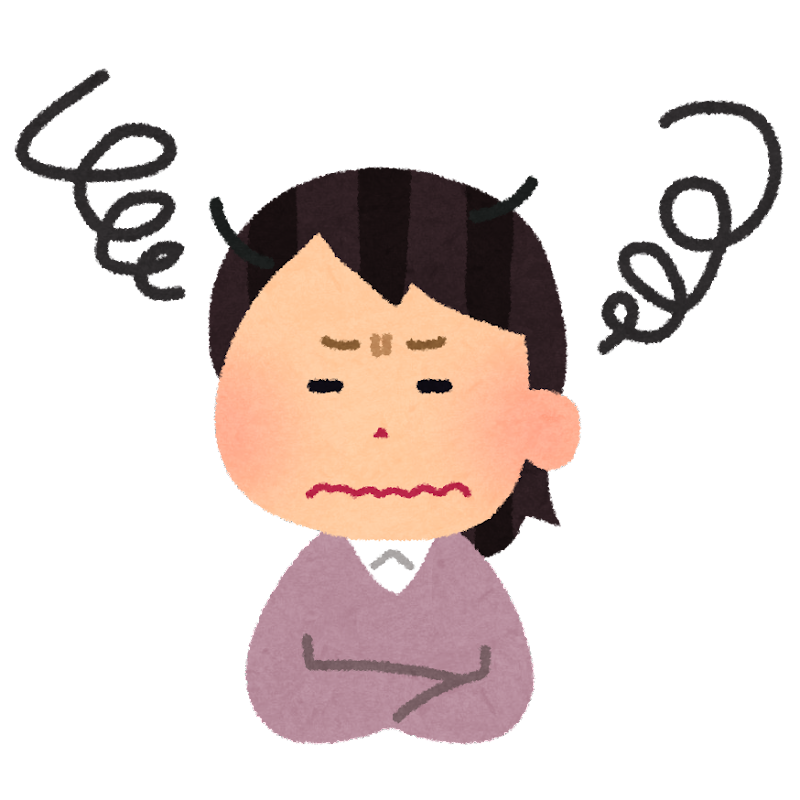
In language learning, and in anything that requires skill, you are always going to start off struggling for a long time until you get better. As mentioned earlier, many learners (I am guilty of this too) fall into the trap of attempting to master something before ever trying to engage in practice with what they need to work on.
For example, a student might fuss over a certain aspect of grammar for way too long and never find the time to move on to something else they are better off spending their time with.
↑ This here is what we want to avoid.
We have to get into the habit of letting go and start doing what we actually need to do.
Yes, you won't understand that book or anime perfectly the first time, but that’s not how learning works. It always takes a third, fourth, fifth and even sixth attempt to finally learn something.
1.5 What even is "immersion"?¶
Immersion is when you interact with natural content in the target language. This means, content that is NOT made for or cherry picked for learners. Content that a native speaker of the language would also consume.
If you were an English learner, reading this guide right now would be "doing your English immersion", because this guide is not watered down or aimed at English learners. It is written for a native/proficient English speaking audience.
Thus, when you listen to, or read Japanese content that a Japanese person would also normally consume, you are doing immersion.
Technically, we would refer to this as input, but I like the term immersion more.
1.6 A top-down approach to learning¶
Learning a language requires you to be content with not understanding everything.
It is drastically different from conventional ways of learning experienced at school where perfectionism is rewarded and you are graded according to an arbitrary criteria or through exams.
Usually, what happens when language learners try to interact with the real language, whether it is a TV series in that language, or a book, or even just having a normal conversation with natives, is they tend to get discouraged extremely quickly due to not understanding everything, or much at all. After all, it can seem counter-intuitive to keep going at it when you understand so little, but as explained earlier, learning a language is like jumping in the deep end.
What sets language learning apart from school-like subjects is it's too based on real-world and natural use that cannot conceivably be covered by study material.
So, the only way you are going to get used to everything is by coming to terms with having low comprehension, because the more we interact with the language, the more we improve.
Of course, you will not be only doing immersion with no aid at all. You will study things like grammar and starter vocabulary on the side, and use dictionaries to learn the words from your immersion.
2.1 How to learn Japanese¶
Beginner study process¶
The learning process for the beginner consists of:
- Learning the hiragana and katakana, which are two of the writing systems of Japanese.
- Learning basic vocabulary and their kanji with a program called Anki.
- Learning grammar through a YouTube playlist.
- Starting immersion with easy content and with high repetition. This is how you will be spending most of your time.
2.2 Hiragana and Katakana¶

Hiragana and katakana are two parts of the Japanese writing system with the third part being kanji
Japanese's writing system can be described as more of a "syllabary" than an alphabet. It is technically wrong to call these alphabets, as each character represents a syllable rather than a vowel or consonant. Take for example, 「か」, which reads as "ka".
Hiragana and katakana are collectively referred to as the "kana".
Hiragana and katakana represent every sound in the Japanese language. While you can technically write Japanese entirely in kana, this isn't how real Japanese is usually written, as it uses a combination of kana (hiragana and katakana), and kanji.
Hiragana¶
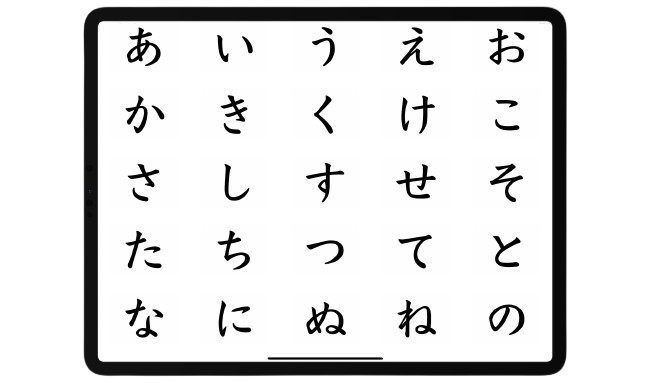
Hiragana can be described as the "main alphabet" of Japanese. It's the curly and cute variant of kana.
It is usually used in:
- Grammatical things
- Parts of words with Japanese origin
- Words that aren't usually written in kanji
It may also be used in:
- Names
Katakana¶
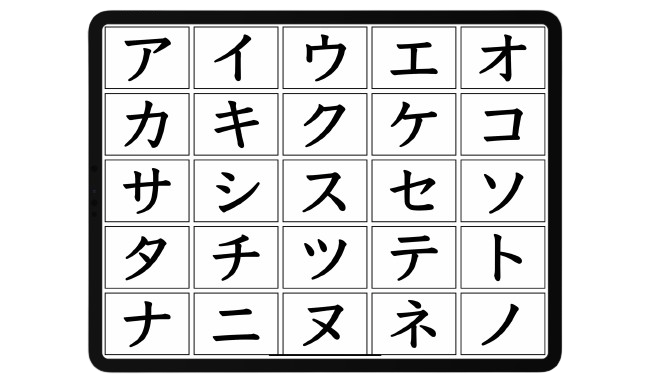
Katakana is the angular and pointy version of kana. It has the exact same sounds as hiragana. It is usually used in:
- Foreign, loan words (words borrowed from other languages like English)
- Onomatopoeia words (Japanese is full of these!)
- Slang words
It may also be used in:
- Names, mainly foreign names
How to learn the kana¶
Step 1 - the chart¶
First I want you to take a good look at this kana chart.

View in browser
Download image
This chart will come in really handy when you are learning to read the kana. I recommend you save it.
Things you can do with the chart:
- Learn to read kana by referring to the table. The columns represent vowel sounds, and the rows represent consonant sounds. Since 「か」 is in the K row and in the A column, it is pronounced "ka".
- Learn how they are written by looking at the stroke orders (the little blue arrows and numbers on the characters).
- Use it as a master reference for all singular kana. This will help you a lot when you are learning how to read Japanese.
Step 2 - the YouTube video¶
Watch this YouTube video
It's a 2 hour long video about hiragana and katakana. It is a great introduction into the kana.
Step 3 - the grinding¶
Once you have done that, play this kana grinding game.
The kana grinding game
How to play
- Click "show/hide options".
- Click "check all" for Hiragana.
- Start guessing how the hiragana are pronounced.
- Repeat until confident (may take a few days or weeks), and then do the same thing but with all "Hiragana combinations" also checked.
- Repeat until confident, then do it with all "Katakana" also checked, and then with all "Katakana combinations" also checked.
This whole process can take up to 3 weeks to a month depending on the person. Do not feel discouraged if this part of learning Japanese is taking a while, as there are other things to do such as beginner level immersion.
Step 4 - reading practice¶
What also helps immensely in memorising the kana is reading sentences in kana.
Not everything in Japanese is written in kana, and you will have trouble trying to read most things at this point without kanji knowledge, but sometimes in Japanese, kana is put over kanji to help you read. This is known as furigana. An example can be seen here!
日本語
. This just means the Japanese language ("nihongo"). I wrote it in its kanji form and put hiragana over it.
I recommend practising your kana by trying to read some Tadoku graded readers, which you can find here.
You do not need to be able to understand anything right now. This is just for getting better at reading kana.
2.3 Vocabulary & Kanji¶
Kanji, the oddball¶
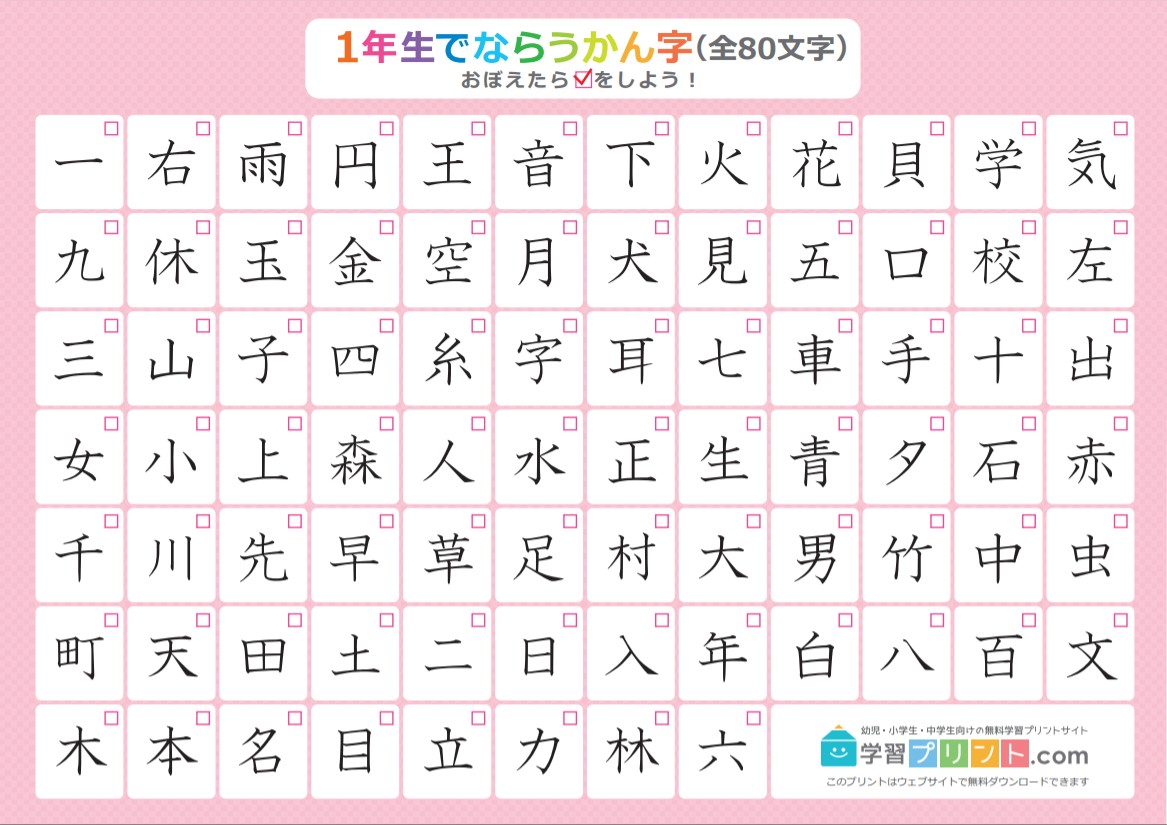
Kanji, meaning "Chinese characters", is another one of the writing systems used in Japanese. They are logographic and are much more complex and wider in variety than kana. There are around 2000 to 3000 of them used in Japanese, however, do not let this number demotivate you, because kanji are not to be studied and grinded like kana are.
Kana are phonetically consistent and few in number so they can be studied in isolation and mastered in a short amount of time, however, kanji are not. They aren't used in the same way either, and aren't exactly logical. What do I mean by that?
Let's take this as an example. Because kana represents the sounds in Japanese, we can write whatever we want according to the sounds as long as a kana exists for it, this includes writing English words.
Now imagine I wrote the English sentence "I am learning Japanese" but using kana, it would be:
"あい あむ らあにんぐ じゃぱにいず"
Of course, this is ridiculous and there is no reason why you would ever want to do that, but the point being: you aren't exactly able to do this with kanji without it being completely unreadable and incomprehensible. But why then, do we use kanji? Because of words. Words use kanji, and therefore...
Kanji only make sense when they are used in words.
I repeat,
Every language has a lot of words, and different words have different meanings. Chinese, and Japanese for whatever reason decided they are going to use kanji to piece together different words and their different meanings. That is why there are so many of them and why you shouldn't let them scare you as they are meant to be learned along with the words that use them. After all... no one is going to think to front-load all the words before they learn how to read! That's ridiculous.
Japanese has extra steps when it comes to learning how to read; due to kanji you need to constantly refer to a dictionary to learn how to read anything at all.
Take this for example, if I showed you the word, 今日, chances are you wouldn't be able to read it, or know what it means. How you learn how to read it is by looking it up in a dictionary, such as Jisho.org.
The dictionary shows it is read as きょう, and means today. If we had to look this word up while reading something, we internalise this piece of information and move on.
Tedious... but there are tools such as Yomitan that can do all this with a single press.
A note on studying kanji in isolation¶
Kanji study methods have been a matter of debate for as long as learning Japanese has been a thing. One of the common problems that arise when beginners try to read Japanese is that kanji can look too similar to each other and that their shapes don't make sense.
While they may look like random shapes, kanji are actually formed from common components. Take for example the kanji 萌, that is being used as the icon for this website. It is actually made up from 3 common kanji components that are used in lots of other kanji as well.

While optional, learners that are struggling to tell apart different kanji may want to try studying kanji by their components in isolation. An additional Anki deck (explained in the next section) can be used to do this. You can find the deck here.
2.4 Learning Vocabulary¶
To get a feel for kanji and how they are used together in words, I recommend you work through a beginner-level vocabulary deck for Anki. This is a deck consisting of around 1500 words aimed at teaching you the most common Japanese words to jumpstart your Japanese learning.
Quick Anki Setup¶
Anki is a flashcard program designed to help you remember large amounts of information, such as vocabulary.
Visit the Anki download page, and download the version of Anki for your system and install it.
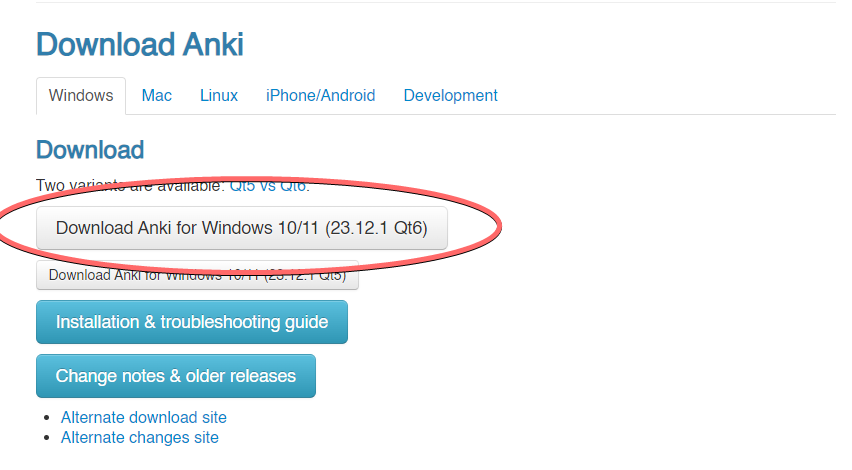
When opening Anki for the first time, you will be asked to set your display language, just leave it at the default (English).
The beginner deck I recommend is Kaishi 1.5k which can be downloaded here (click the .apkg link)
After the download is complete, import the deck by clicking "Import file" and navigating to the downloaded file (.apkg) and then click Import on the top right.
Quick Anki Usage Guide¶
Before studying, I recommend changing some settings first. Click the cog icon next to the deck, and go on Options.
Change the Maximum reviews/day from 200 to 9999. Don't be alarmed by this number, your reviews probably won't ever reach that high, it's just uncapping your daily review limit for the optimal experience.
As for New cards/day, I think 20 might be too big of a commitment for some. If you aren't feeling confident learning 20 new words per day, try dropping the number down to 10 or lower.
When you first start studying the Kaishi 1.5k deck, the first card will be an explanation card. You can delete this by going in "More" and clicking "Delete Note"
Anki helps you remember things by testing your knowledge of what is on the back of the card. What you are being tested for here is whether you know the meaning and how to read the word. Everything else on the card is only there for aid.
Please note that while Kaishi 1.5k includes sentences, it is only designed to teach you single words.
When seeing an unfamiliar Anki card for the first time, the general rule of thumb is to click Show Answer so you can see what's on the back of the card.
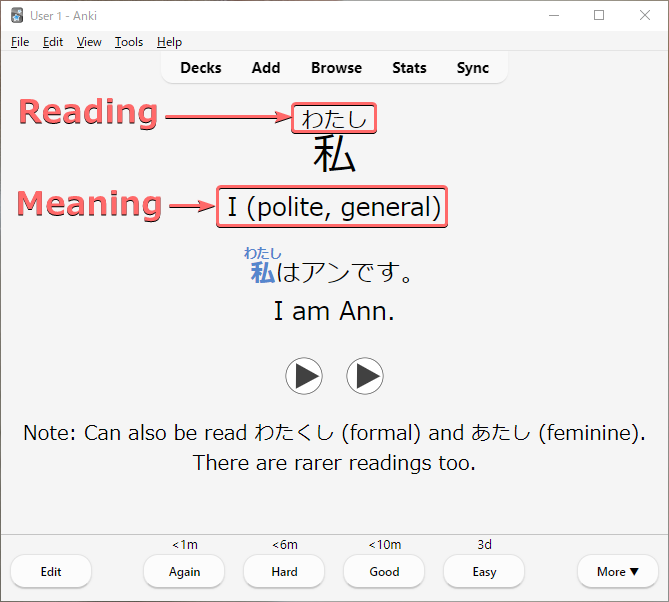
Once you have had a good look, press Again (this is short for try again). You will be on the next card, do the same thing as it is also a card you are seeing for the first time.
The next time you see the card, it is knowledge testing time. Try your best to remember the meaning and reading that was on the back of the card and grade yourself!
This, in essence, is how we are going to learn vocabulary in the beginner stage.
Once you have completed your new cards for the day, make sure you come back the next day to check your reviews!
2.5 Grammar¶
Learning grammar can be straightforward and complex at the same time. It's quite essential to learning Japanese and while it might seem daunting at first, there are resources out there that help make the learning process easier. The grammar learning process is relatively simple; just pick up a guide and read/watch it.
There have been many resources throughout the years that teach grammar, many great and many not so great. Due to the nature of the topic, just one grammar resource may not be enough for everyone.
Here are a few guides ranked based on how much I recommend them to total beginners You do not need to do every single one, just find the one that works well for you.
Cure Dolly's Organic Japanese YouTube Playlist (transcript)
Tae Kim's Guide to Japanese
Japanese Ammo with Misa Grammar YouTube Playlist
Sakubi
IMABI
It is prime time to start getting some immersion going when you have learned some new grammar points. Seeing how the grammar you learned is applied in real usages really helps further your understanding of the grammar points.
2.6 Beginner immersion: an uphill battle¶
If you recall from section 1.3, I touched on something known as comprehensible input. This is input that is understandable at your level, where there’s just a few missing pieces of the puzzle every few sentences. With this sort of immersion, you subconsciously fill in the incomprehensible parts with educated guesses based on context, which is what makes this type of input so useful for the purposes of language learning.
Now you may have noticed a problem here. What do you do if you don’t have access to comprehensible input? As a complete beginner, there is no content that is easy. In fact, this is why people often fall into the endless cycle of reading from beginner resource to beginner resource. Though incomprehensible input is by no means useless—it does have its benefits and assists with learning—it is very difficult to get past that initial hurdle.
Failing to understand the content you want to enjoy inherently sucks unless you take a specific mindset to it—taking pleasure in the knowledge that you are making gradual progress, even if that progress is immediately imperceptible. However, it’s difficult to maintain this mindset all the time, so it isn’t reliable as the sole motivator for consistency—the number one key of mastering any skill!
So how can we make it so we don’t constantly dread having to parse through content that is difficult to understand?
The answer is actually very simple. Fun! Media can be entertaining for reasons other than language content. By choosing media that also has high entertainment value regardless of its language level, we are able to stay consistently engaged and motivated to continue our immersion. Then, as our language experience grows, we naturally find ourselves understanding more and more, and the once seemingly unattainable goal of finding comprehensible input has now become a given, with the goal rather shifting to finding content that is difficult enough to push us to continue learning.
2.7 How to immerse¶
Reading & Dictionaries¶
To make Japanese less of a pain to read, you can use a free browser extension known as Yomitan. You can find a tutorial on how to use it here
To look up words individually, you can use Jisho.org, apps for your phone include Akebi for Android and Shirabe Jisho for iOS.
Choosing immersion content¶
Honestly, pick whatever you want. It can be any anime, movie, J-drama, novel, light novel, manga, visual novel, game or YouTube video. If you don't have anything in mind you can just watch my favourite anime. Just make sure you're actually interested in whatever you're choosing to immerse with!
How to immerse with listening¶
Listening is almost entirely a top-down, "intuitive" approach. We don't want to think too hard over things when we are listening. Go with the flow until you find a really good oppportunity to pause and look something up.
There are certain levels to listening. Level one would be free-flow listening, where you let the listening flow without looking things up. Level two would be looking things up that pop out at you but still letting the listening play. Level three would be pausing at every single unknown word and looking them up.
In the beginner to intermediate stages, listening is entirely level one and level two listening. Don't think too hard about it and cherish all the little opportunities you get.
"Active" and "Passive" listening¶
Active listening is when you are paying full attention to your listening. You are engaging with all aspects of it like looking at the screen and listening to the anime. This is the type of listening where you are making the most gains.
Passive listening is where you do something else and have the listening on in the background. This helps when you intermittently listen in on your listening for brief moments, it can hugely benefit you if you have a busy lifestyle. I actually recommend doing passive immersion to fill in the gaps where you're usually not doing Japanese.
How to immerse with reading¶
In contrast to listening, reading is sort of a bottom-up, take-your-time, "analytical" approach. You can take as much time as you'd like reading sentences and looking up words. The process loop is essentially read → look up word → reaction → read more → look up word → (repeat). For a while, it is going to seem like banging your head against a wall, but this is really just how you're going to build up reading ability.
Reading content with a visual component such as anime with Japanese subtitles (detailed in UsagiSpoon), manga and visual novels can help ease you into reading.
Ideal ratio between listening and reading¶
In the beginner stage I recommend a 7:3 listening to reading ratio. This is mainly because listening is the most natural form of the language, so I believe it is essential to prioritise it to make your brain process Japanese more naturally.
You can start to lower the amount of listening to an equal 5:5 ratio when you get better at Japanese.
2.8 Beginner learning loop¶
The wrong way to do it¶
The wrong way
Learn ALL the kana, then learn ALL the 1500 words in Kaishi, then learn ALL the grammar before you finally try immersion for the first time...
This is a terrible approach. You need to do a bit of everything.
The right way to do it¶
While you are learning the kana, I suggest you get into the immersion spirit by trying to watch something in Japanese without subtitles. It can be anything you like, and you don't need to understand anything.
After that you should learn vocabulary and grammar at the same time. How about doing 10 new words and learn 2 grammar points per day? And in the same day, try to get some immersion in.
How long should I do immersion per day?
I recommend around 1 hour to 2 hours when starting out. There is no harm in doing more immersion than that, and you will improve faster with more immersion per day.
3.1 Regarding speaking and writing (output)¶
People often have the misconception that speaking the language a lot is how you get better at the language, but this isn't really the case, as the input we receive from hearing and seeing natives use their language is what actually benefits us. While output won't directly improve your proficiency at the language, it is still quite important to be practicing output, whether it is by texting or with speech, because input and output go hand in hand. Doing output effectively forces your brain to make sure it is correctly understanding the words you are hearing and you may start to subconsciously look for opportunities to use what you hear in input.
Regular output along with regular input is recommended.
Contrary to what many immersion-based learning methods say, I do not believe it is a smart idea to delay your output until you are "really good" for reasons such as "saying things incorrectly is going to "cripple" or "ruin" your Japanese". Doing this makes you miss out on so many opportunities to pick up on things to use in your output earlier and brainwashes you into a toxic perfectionist mindset, becoming extremely protective of your Japanese.
Throughout my 4+ years of running TheMoeWay and talking to all sorts of immersion learners, I haven't seen many that are confident in output. Why is that? Well for most of them, they don't even want to try outputting at all because they're scared of saying something broken, or scared that it's going to ruin their Japanese, or scared that somebody may laugh at them etc. All of this is a product of a toxic perfectionist mindset that hurts immersion learning.
3.2 Pronunciation & Pitch Accent¶
Compared to language communities and resources for literally every other language out there, Japanese resources, tutors and learners always tend to make pronunciation an afterthought because Japanese pronunciation is simple. Yes it is simple, and yes you don't need to worry about being misunderstood but it may be in some learners' goals to have good pronunciation.
I am going to add this guide to the list of resources that say you don't need to study pronunciation by saying: if you don't really care about sounding amazing, then don't bother fussing over your pronunciation.
Learners that want to go the extra mile may want to look into learning pitch accent and the correct IPA pronunciation on their own, ideally as early as possible.
3.3 Learning milestones¶
For those that are curious, here is the level of Japanese ability you can expect to have after reaching these milestones.
- 10 raw anime series: You are really starting to get the hang of listening to Japanese. You are probably able to understand a good chunk of sentences now. Anime you watched at the beginning of your learning journey are going to feel so much different!
- 25 raw anime series: At this point listening to Japanese is going to feel more natural than ever before.
- 50 raw anime series: If you have been keeping up with your study... then I can't really consider you a beginner anymore at this point. There's going to be a huge difference between your abilty now compared to when you were starting out!
- 1 full novel finished: While you had a really rough time trying to understand this book, you are beginning to really shoot out of the beginner stage. The next book you read will be noticeably easier.
- 5 novels finished/1 medium to long VN: I wouldn't consider you are a beginner anymore. You are really beginning to build up good Japanese reading proficiency.
- 10 novels/2 medium to long VNs: Completely intermediate at this point. Congratulations!
3.4 Closing notes: post-beginner stage and beyond¶
There isn't really much else to the learning process other than immerse a lot and learn words and grammar. You can really get fluent at Japanese with this method. But one thing does change when you leave the beginner stage.
Learning vocabulary with Anki will become much more personal as you will be making your own cards from words found in your immersion in a process we call mining. The recommended mining guide is Donkuri's mining guide. Mining will essentially become the heart of your Japanese study.
Thank you so much for taking your time to read this guide and I wish you good luck on your Japanese learning journey!
If you have any questions, you can ask away at our Discord server.
Patreon¶
If you found this guide useful in your Japanese learning journey, a Patreon donation would be highly appreciated!
Contributors¶
I'd like to thank everyone that has contributed to the making of this guide:
iamatryhard
shigatsunoraion
qazsedctgb
ktamashi
kaio.n
saegusa.mayumin
pedipanol
.ikki.
ultravioletspring
deviru
kazuhira___
marv.n
